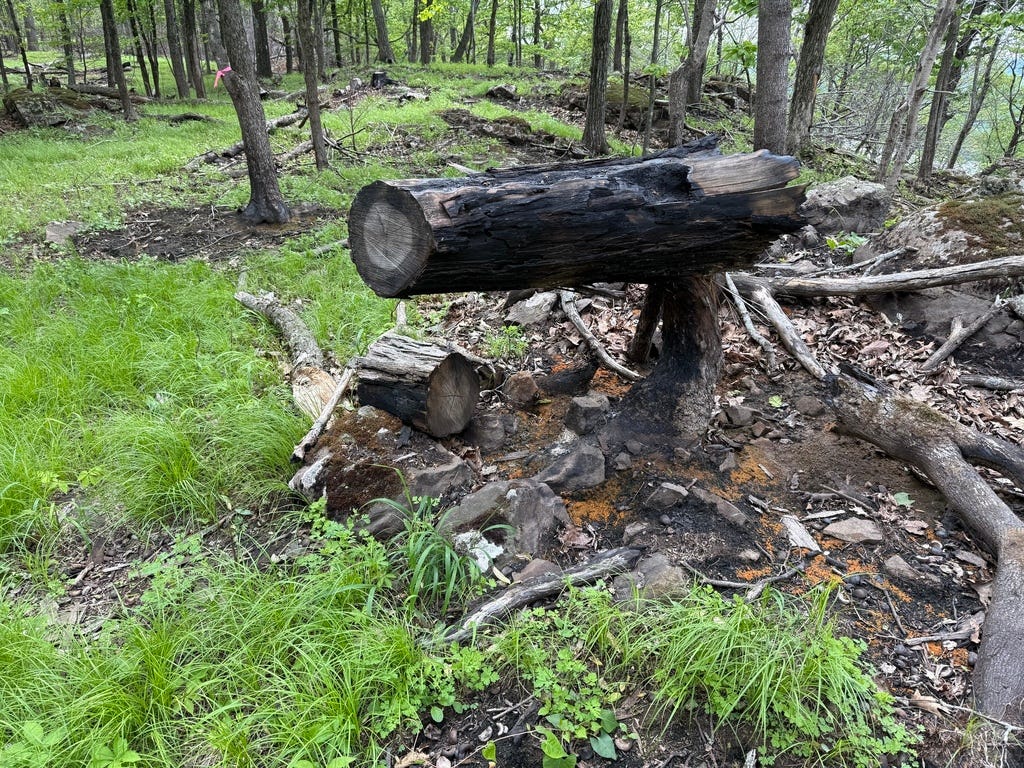Good evening, friends,
I found this week’s mushroom both yesterday and today as I poked around a couple burn sites from last fall’s wildfires. I was able to pop down to Sterling Forest State Park in Tuxedo, NY yesterday, and then stopped at Lamentation Mountain State Park in Berlin, CT this afternoon (…in what was supposed to be a quick visit until I lost and then found my binoculars). In both locations, especially today, the charcoal eyelash cup (Anthracobia melaloma) could be found fruiting gregariously across the forest floor.
These saucer-shaped mushrooms may be small in stature, but clearly there’s strength in numbers when they come together to act as the forest’s first responders after a wildfire.
Fun Facts
It’s thought that the fungus’s spores are ever-present in the air. After a wildfire, the spores land on the freshly scorched earth and they take a liking to the alkaline (basic, high pH) soil. The mycelium proliferates; it helps to congeal the exposed soil and prevent erosion. The fungus also breaks down the charred organic material enough to allow for the next organisms in the post-wildfire ecological succession to get a foothold.
The fungus possesses a unique compound, Ascopyrone P (APP), which has demonstrated antimicrobial activity in a lab setting (in vitro, as they say). APP inhibited the growth of both gram-positive and gram-negative bacteria, and the researchers postulated that it could potentially be used as a natural food preservative. More research is needed before we can start pumping this in our food, but a little APP cereal might be nice. Who’s to say?
The etymology of Anthracobia is a combination of the Greek anthrax which means “coal” and kobia which means “cavity” or “hollow”. The name refers to the charred substrate which the mushrooms inhabit. Interestingly, I did notice that they would cluster so tightly in some spots that the group lifted off the earth and there would be a hollow area in between them. The species epithet melaloma breaks down to the Greek mela which means “black” and loma which means “edge”, and the name refers to the dark edges of the cups.

Ecology
A. melaloma is a pyrophilous fungus — a very early colonizer of scorched soil left in the wake of wildfires. I noticed that the mushrooms were only growing in the severely charred areas where the soil was still black from the fire. These scorched areas usually occurred around the base of trees and wherever there was dead wood (areas where the fire had more fuel). The cups are small, ranging from a couple millimeters across to, very infrequently, a couple centimeters — but they had no problem covering large swathes of the charred, barren forest floor.

The mushrooms I found yesterday in NY were more of a brownish orange which made me think they’re a little older than the vibrant cups I found today. That could be because that area of central Connecticut is a little further behind in spring than the very southern part of New York, and the cups may fruit in early to mid-spring in the northeast.
These ascomycetes typically fruit within six months of a wildfire. They can be found in Europe and across North America, particularly west of the Rockies where fires are more frequent and substantial. I imagine at some point DNA sequencing will reveal that there are genetically distinct species within A. melaloma that are separated based on their geographic location — unless the spores really are that ubiquitous and can float around the world.
Upcoming Events and a Podcast Plug
5/24: The Cape Cod Mycological Society is having our first walk of the season at 10 AM in Beebe Woods in Falmouth, MA. Hope to see you there:)
5/30-6/1: Maine Fungus Festival at Saint Joseph’s College in Standish, ME
6/13-6/15: Friends of Fungi Retreat at Menla in Phoenicia, NY.
Also, for those of you like me that find yourself snug in the middle of the venn diagram of mycophiles and runners (some Mushroom Mondays even originate on runs), check out the podcast Runnah hosted by friend, Julianna. She conducts interviews with other runners, talks training, and will even break down which shoes will work for you.
Have a great Memorial Day Weekend and hopefully I’ll see you out there somewhere in the woods,
Aubrey
References:
Thomas LV, Yu S, Ingram RE, Refdahl C, Elsser D, Delves-Broughton J. Ascopyrone P, a novel antibacterial derived from fungi. J Appl Microbiol. 2002;93(4):697-705. doi: 10.1046/j.1365-2672.2002.01751.x. PMID: 12234354.
https://www.inaturalist.org/taxa/381249-Anthracobia-melaloma








Beautiful- thanks for sharing
Very interesting piece. Thanks Aubrey.